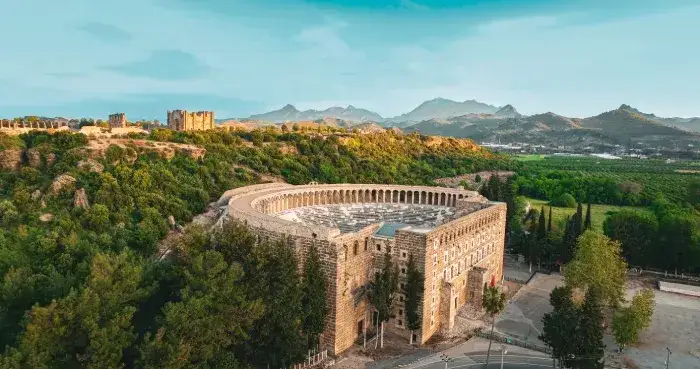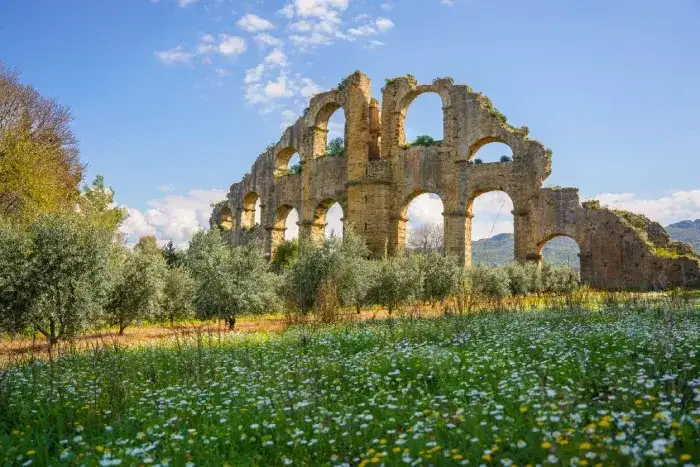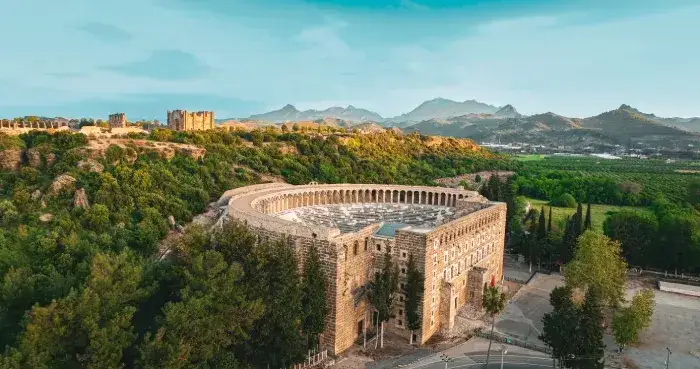Aspendos: Turkey's Ancient Theater and Timeless Legacy
Aspendos, Turkey, is Situated in Serik town in Antalya province. It impresses visitors with its elegant amphitheater and other ancient remains. Read More!

Ancient Roman grandeur lives on through the magnificent ruins of Aspendos, a remarkable city welcoming thousands of visitors yearly - a testament to its enduring allure, though lesser known than Pompeii's 2.5 million annual visitors. Greek colonists established this marvel during the 5th century BCE, setting the stage for its golden age under Roman rule during the 2nd and 3rd centuries CE.
Towering above the ancient landscape stands the crown jewel of Aspendos - its legendary theater. Master architect Zenon crafted this architectural masterpiece between 160-180 CE, dedicating his creation to Emperor Marcus Aurelius. Modern audiences still experience performances within these ancient walls, just as Romans did two millennia ago. Spectacular Roman engineering prowess reveals itself through 41 meticulously crafted seating tiers, accommodating approximately 7,000 to 13,000 spectators. Visitors gaze in wonder at the monumental façade, stretching an impressive 96 meters wide and soaring 22 meters skyward.

Daily Life in Ancient Aspendos
Life pulsed through the carefully orchestrated streets of Aspendos, radiating outward from its bustling agora - the beating heart where commerce, society, and politics intertwined in a daily dance of activity.
City layout and planning
Masterful urban design revealed itself through the city's architectural blueprint, crowned by the agora's perfect symmetry atop the central hill. Along the western boundary, an impressive double-storied marketplace, its stone walls echoing with centuries of merchant calls. The Market Basilica stood as another architectural triumph, its spaces alive with the constant flow of traders and citizens conducting their affairs.
Social structure
The vibrant fabric of Aspendian society was intricately woven with threads of commerce and civic responsibility. The city's influence and power were so substantial that it maintained the esteemed right to produce its currency.
Trade activities
Aspendos flourished as a trade powerhouse, and its reputation built upon prized exports:
- Salt and oil production
- Wool Manufacturing
- Agricultural bounty including grain and wine
Nature blessed the city with an enviable position near the Eurymedon River, merely 16 kilometers from the Mediterranean's azure waters, powering its commercial might. The city's coins, discovered across the ancient world, proclaimed Aspendos as Pamphylia's supreme commercial force during the 5th century BC. Today, the Market Basilica's enduring columns and arches stand sentinel, whispering tales of the economic glory that once crowned this prosperous realm.

Daily Life in Ancient Aspendos
Life pulsed through the carefully orchestrated streets of Aspendos, radiating outward from its bustling agora - the beating heart where commerce, society, and politics intertwined in a daily dance of activity.
City layout and planning
Masterful urban design revealed itself through the city's architectural blueprint, crowned by the agora's perfect symmetry atop the central hill. Along the western boundary, an impressive double-storied marketplace, its stone walls echoing with centuries of merchant calls. The Market Basilica stood as another architectural triumph, its spaces alive with the constant flow of traders and citizens conducting their affairs.
Social structure
The vibrant fabric of Aspendian society was intricately woven with threads of commerce and civic responsibility. The city's influence and power were so substantial that it maintained the esteemed right to produce its currency.
Trade activities
Aspendos flourished as a trade powerhouse, and its reputation built upon prized exports:
- Salt and oil production
- Wool Manufacturing
- Agricultural bounty including grain and wine
Nature blessed the city with an enviable position near the Eurymedon River, merely 16 kilometers from the Mediterranean's azure waters, powering its commercial might. The city's coins, discovered across the ancient world, proclaimed Aspendos as Pamphylia's supreme commercial force during the 5th century BC. Today, the Market Basilica's enduring columns and arches stand sentinel, whispering tales of the economic glory that once crowned this prosperous realm.
Customize Your Dream Vacation!
Get in touch with our local experts for an unforgettable journey.
Plan Your TripBuilding the Theater of Aspendos
The magnificent theater of Aspendos was built stone by stone, showcasing the remarkable architectural skills of the Romans.
Architect Zeno's vision
Genius flowed from the mind of Zenon, Aspendos's native son, whose Greek heritage shaped every calculated angle of his masterwork. Mathematical precision guided his hand as he crafted a structure spanning 96 meters, its stage measuring exactly half this width. Zenon's brilliance shone brightest in his marriage of architecture with nature - the theater embraced its hillside perch, the natural slope cradling the cavea while offering perfect sightlines for every spectator.
Construction timeline
Two wealthy brothers, Curtius Crispinus and Curtius Auspicatus, answered Emperor Marcus Aurelius's call to fund this monumental undertaking. Local limestone yielded its strength to Roman engineering mastery, each block precisely cut and positioned.
Architectural innovation flourished throughout the design:
- Twin-tiered stage walls adorned with columns, niches, and watchful statues
- Sound-perfecting semicircular orchestra space
- Diazoma-split cavea creating distinct viewing sections
- Acoustic wizardry carrying whispers to the farthest seats
Roman builders carved 41 rows of seats into the hillside, forming a graceful horseshoe that welcomed around 13,000 spectators. The stage building reached skyward, its towering presence both practical and magnificent, creating an intimate sanctuary for theatrical magic.
Greek architectural wisdom guided the theater's fundamental form - visible in its horseshoe shape and hillside embrace. Roman ingenuity added its signature through barrel-vaulted foundations and an enclosed performance space that transported audiences into another world.
Art and Architecture Features
Architectural splendor radiates from every stone of the theater, where intricate stage designs dance with ornate decorations to create an enduring masterpiece.
Every stone in the theatre represents architectural splendor, the intricate stage design dancing with all ornamentation into an enduring creation.
Stage design elements
Majestic twin stories pierce the sky, with 17 windows framing glimpses of azure heavens.
Classical beauty unfolds through Ionic columns gracing the ground floor while Corinthian capitals crown their upper-level counterparts. Drama flows through five carefully positioned doorways in the scaenae frons, the great porta regia commanding center stage, flanked by four noble portae hospitals. A clever wooden canopy once sheltered performers while enhancing the projection of their voices.
Decorative details
The artistry of Antonine reaches the last stage in theatrical ornamentation. The Ornamentation of the stage building is a great expression of Roman artistic mastery:
- Marble niches, displaying heads, masks, dolphins and flowering vines
- Dionysus wields his scepter over the central relief, entwined in botanical splendor
- Twenty proud columns rise in perfect squares across two majestic tiers
- Brilliant turquoise tiles shine with a gleaming touch, a legacy of Seljuk craftsmen
Seating arrangement
Roman social hierarchy manifests in stone through the diazoma - a horizontal pathway dividing spectator spaces. Noble citizens claimed 20 rows below, while 21 rows above accommodated the general populace. Each patron enjoyed 45 centimeters of carefully carved comfort.
The "Emperor's Lodge" commands the best vantage from its prime position. Ancient patrons left their marks in the form of names etched in stone. Such is the genius of the architecture that even whispered words float clearly to every ear, enclosed within the perfect acoustic embrace of the theater.
Survival Through Centuries
While time flows like water around the stones of Aspendos, this architectural masterpiece still stands unbowed testament to human ingenuity and adaptability across ages.
Seljuk adaptation
The 13th century saw destiny write a new chapter for Aspendos as the Seljuk banners unfurled above its ancient stones. Sultan Ala ad-Din Kayqubad I's vision breathed fresh life into the venerable theater. Seljuk artisans wove their magic through ceramic tiles and geometric paintings, transforming the Roman stage first into a sultan's summer sanctuary, and then into a welcoming caravanserai. Their caring hands reconstructed the northern and southern towers, painting unique red zig-zag patterns and creating plasterwork that still catches the sun today.
Natural preservation factors
Ancient wisdom married to natural grace preserved this architectural treasure through:
- Skillful Roman engineering joined the cavea and stage building into one harmonious whole
- Nature's contribution-the hillside's eternal embracing of this mighty cavea
- The unbroken chain of purpose through Byzantine and Seljuk stewardship
Seljuk's reverence for Aspendos's grandeur proved its salvation. Their preservation touch extended beyond the theater walls to restore the mighty Eurymedon Bridge, maintaining vital arteries of trade across Anatolia.
Every century left its layer of care in the story of the theater. The visionary founder of modern Turkey, Mustafa Kemal Atatürk, ordered vital renovations in the 1930s, realizing the timeless value of the theater. Though debated by scholars, this intervention secured the future of the theater. UNESCO recognized this remarkable survival story in 2015 when it added both theater and aqueducts to its World Heritage Tentative List.
The endurance of Aspendos Theater is rooted in its living spirit abandoned, always changing, yet retaining its essential character. This delicate dance between preservation and evolution, nurtured by Seljuk wisdom and modern guardianship, allows ancient stones to speak across millennia, bridging past and present in eternal dialogue.
In every stone of the Aspendos Theater, Roman genius breathes, where the wisdom of antiquity meets timeless beauty. The vision of the great master architect Zenon still fascinates modern audiences with perfect acoustics and pristine architectural details.
Centuries have blessed this architectural triumph, secured through ingenious Roman engineering and unbroken chains of purpose. Every age wrote its chapter in the story of the theater, from jubilant Roman performances to the quiet dignity of a Seljuk palace, finally emerging as a treasured window into antiquity.
Aspendos is a lot more than a survivor, for the wisdom of ancient builders, under the protecting hand of successive civilizations carefully guarding it, preserved every single detail of this 13,000-seat marvel for centuries. Modern visitors tread on the very stones crossed so long ago by Roman citizens, while today's performers command that very stage that once reverberated with ancient voices.
In these eternal walls, past and present dance an eternal duet. Aspendos Theater reminds us that true architectural genius speaks across millennia, transcending mere stone and mortar to touch something eternal in the human spirit. Here, ancient Rome's creative force lives on, teaching each new generation that beauty, wisely crafted, never truly fades.

FAQs
Q1. What is Aspendos famous for?
Aspendos is famous for its well-preserved Roman theater, built in the 2nd century CE, renowned for its stunning architecture and exceptional acoustics.
Q2. Where is Aspendos located?
Aspendos is located in Antalya Province, Turkey, near the town of Serik, approximately 40 km east of Antalya.
Q3. Who built Aspendos Theatre?
The theater was designed by Zenon, a native Greek architect of Aspendos, during the reign of Emperor Marcus Aurelius. It was funded by two wealthy brothers, Curtius Crispinus and Curtius Auspicatus, showcasing the city's prosperity and cultural importance.
Q4. Is Aspendos worth visiting?
Yes! While the theater is the main attraction, Aspendos also boasts other impressive structures from its Roman golden age. These include a basilica, fountains, and aqueducts. The city's rich history as a significant commercial hub in ancient Pamphylia adds to its archeological importance.
Q5. What does Aspendos mean?
The exact meaning of "Aspendos" is unclear, but it is believed to have originated from an ancient Anatolian or Greek name. Some scholars suggest it may be linked to the local Pamphylian language.
























































